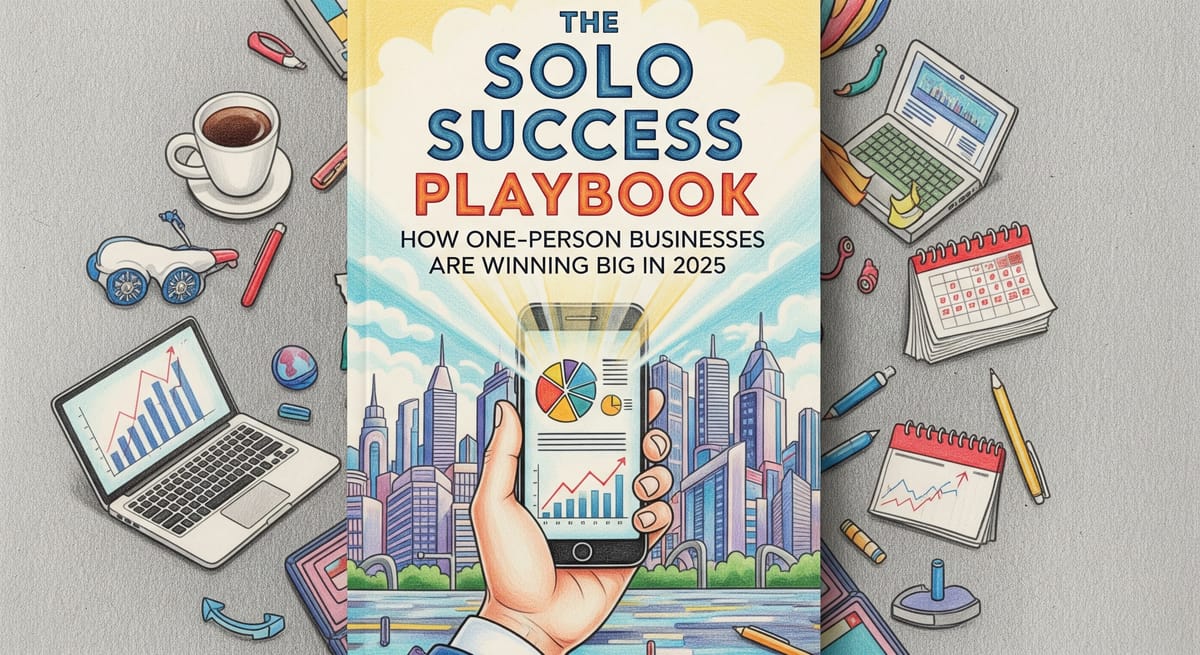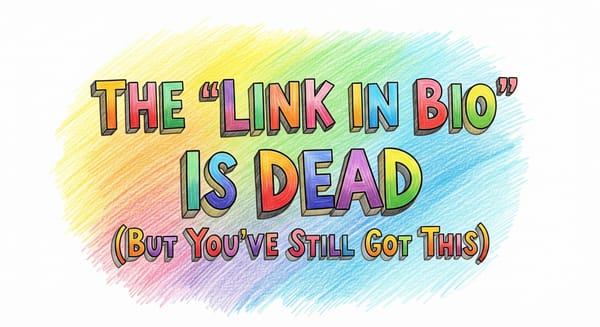The Solo Success Playbook: How One-Person Businesses Are Winning Big in 2025

The myth of needing a big team to build a big business is officially dead. In 2025, the solo entrepreneur isn't just surviving – they're thriving in ways that make corporate giants nervous. I've watched this shift happen over decades of building businesses, and what's happening now is nothing short of revolutionary.
Let me explain…
The Solo Revolution Is Here
• The lean advantage is winning the day. While traditional companies struggle with bloated teams and endless meetings, solo entrepreneurs are making decisions in minutes and pivoting in hours. This nimbleness isn't just nice – it's becoming the ultimate competitive edge.
True story: Last month, I spoke with Janet, a former marketing executive who now runs a $400K/year consulting business from her home office. When a major industry shift happened overnight, her former employer spent three weeks in strategy meetings. Janet adapted her entire service offering in a single afternoon and actually gained clients during the transition.
• Niche mastery has become the new scale. The most successful solo operators aren't trying to capture entire markets – they're becoming undisputed kings and queens of tiny, profitable kingdoms.
That's the magic of it. Finding a niche within a niche means you can charge premium prices and face almost zero meaningful competition. One of my readers found tremendous success not just in personal finance coaching, but specifically helping divorced women over 50 rebuild their retirement portfolios. Highly specific? Yes. Incredibly valuable to that exact audience? Absolutely.

The 2025 Solo Success Toolkit
• Automation is the silent partner. The solo businesses crushing it in 2025 have effectively built themselves a digital team without the actual humans. The right automation stack can handle what used to require 3-5 employees.
You don't need special skills to set this up anymore. Today's no-code tools are designed for the non-technical founder. I've seen grandmothers building sophisticated client onboarding systems that would have required a developer team just five years ago. The tools have finally caught up to the vision many of us have had for years.
• The subscription mindset has transformed cash flow. One-person businesses that struggled with feast-or-famine cycles have discovered the stability of recurring revenue models – even in unlikely industries.
Here's a simple trick: Almost any service can be "subscriptionized." A house painter I know created a "Fresh Home" quarterly touch-up subscription where he handles small repairs and touch-ups every season. His income is now predictable, his clients' homes look better year-round, and he's working less than before.
• Time leverage is the new financial leverage. The most successful solopreneurs aren't working 80-hour weeks. In fact, many are working less than 25 hours while earning more than they did in executive positions.
This isn't about "hustling" harder – it's about being ruthlessly selective about where you spend your time. The old "time is money" cliché has been replaced with "time is leverage." Every hour must generate multiples of what a single hour of work would normally produce.
The Five Principles of Solo Success in 2025
• Decision velocity beats decision perfection. The ability to make good-enough decisions quickly rather than perfect decisions slowly has become the defining trait of successful solo entrepreneurs.
I've built 32 businesses over my career, and I can tell you that the speed of implementation almost always beats the quality of the idea. A mediocre idea executed immediately will outperform a brilliant idea executed "someday" every single time. This gap has only widened in 2025's fast-moving markets.
• Energy management has replaced time management. The old productivity systems focused on squeezing more tasks into each hour. Today's solo success stories focus instead on maximizing energy during fewer, higher-quality working hours.
It's easier than you think – let me prove it. Most people try to force productivity when their energy is low. The new approach is to map your natural energy cycles and schedule your most important work during your peak periods. Then protect those windows religiously. One writer I mentor increased her income by 40% while writing three fewer hours per day simply by shifting when she writes.

• Client selection is the new business strategy. The "take whatever comes through the door" approach has been replaced by strategic client curation. The most profitable one-person businesses have fewer, better clients.
This applies whether you sell products or services. When you serve everyone, you serve no one particularly well. When you narrow your focus, you can create experiences so tailored that price becomes a secondary consideration. One consultant I know charges 4x industry rates but maintains a waiting list because he works exclusively with a specific type of business owner and understands their needs better than they do themselves.
• Brand of one beats faceless corporation. Personal connection has become the ultimate competitive advantage that big companies simply cannot replicate at scale.
Let me explain why this matters: In a world of endless corporate sameness, people crave authentic connection. When clients work with you, they want YOU – not some interchangeable service provider. The solopreneurs winning biggest in 2025 have embraced their quirks, opinions, and personal stories as business assets rather than liabilities.
• Intentional constraints create freedom. The most successful solo entrepreneurs aren't trying to do everything – they're deliberately limiting their offerings, audience, and methods.
That's counterintuitive, I know. But constraints are like the banks of a river – they don't restrict the flow, they intensify it. One designer I work with offers exactly one service, delivered one way, to one type of client. She charges premium rates, works 20 hours a week, and has a three-month waiting list. The business feels almost effortless because she's eliminated all the complexity.
Real Solo Success Stories From 2025
• The Accidental Empire Builder. Michael started with a simple YouTube channel reviewing camping gear in 2023. By 2025, his one-person business generates $750K annually through a combination of affiliate partnerships, a premium membership community, and a small line of branded products manufactured by partners. He works approximately 25 hours per week and runs the entire operation without employees.
The key lesson? He didn't try to do everything himself. Michael focused on his strengths (content creation and community building) while leveraging partnerships for everything else. This "strength-only" approach is becoming the standard operating model for successful solopreneurs.
• The High-Ticket Specialist. Elena transitioned from being an overworked marketing agency employee to a specialized consultant working with just 8 clients per year at $75,000 per engagement. Her focus on one specific industry problem (customer retention systems for subscription box companies) allowed her to develop unmatched expertise and command fees that would have seemed impossible in a generalist role.
What makes her model work is the depth rather than breadth of her knowledge. By going incredibly deep into one narrow area, she's positioned herself not as a service provider but as an investment that pays for itself many times over.

• The Digital Craftsman. James combined his carpentry skills with digital content to build a business that generates over $500,000 annually without selling a single physical product. His detailed digital plans, online courses, and membership community serve over 40,000 woodworking enthusiasts. Despite the substantial revenue, he maintains the entire operation himself with carefully selected tools and systems.
The breakthrough came when James realized he didn't need to scale by hiring – he could scale by creating systems and leveraging digital distribution instead. His workshop remains a one-person operation, exactly as he prefers it.
Your Solo Success Action Plan
If you're inspired to build your own solo success story, here's where to start:
Begin with energy optimization, not time management. Track when you naturally feel most focused and creative, then restructure your schedule to match those patterns.
Implement the "niche squared" strategy. Take your current market focus and narrow it further by either industry, demographic, problem type, or delivery method. Then test if this more specific positioning resonates more strongly.
Audit your current tools and processes. Identify the three most time-consuming operational tasks in your business and research automation solutions specifically for those functions.
Develop your "one-person brand" positioning. Clarify how being small gives your clients advantages that working with larger competitors cannot match.
Create your client selection criteria. Document the exact characteristics of ideal clients or customers you want to work with – and those you'll now decline.
The beauty of solo entrepreneurship in 2025 is that you don't need to follow someone else's blueprint. The constraints and advantages of your specific situation can become the foundation of your unique approach.
As I often remind my readers at https://alunhill.com – the path to business success isn't about copying what worked for others. It's about understanding the principles behind their success and adapting them to your unique strengths and circumstances.
The era of the thriving one-person business isn't coming – it's already here. And it might just be the most exciting time in history to be a solo entrepreneur.



